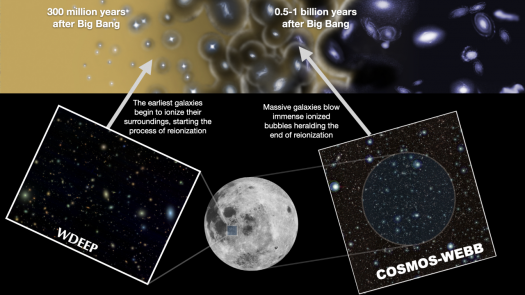COSMOS-Webb and WDEEP
Together, the WDEEP and COSMOS-Webb large JWST first-year programs will probe reionization, the period where galaxies burnt off the cosmic haze of residual gas leftover from the Big Bang.
WDEEP, by staring at a single small patch of sky 1.5% the size of the full Moon, targets the beginning of this process, searching for the first galaxies to form out of the cosmic dark ages only 300 million years after the Big Bang. COSMOS-Webb targets the next phase of cosmic history, where massive galaxies have begun to ionize enormous regions of space, heralding the end of reionization. These observational strategies are complementary.
COSMOS-Webb probes an area 3 times the area of the full Moon to scan a wide area of space for rare, massive galaxies, while WDEEP drills 15 to 20 times fainter in a single narrow region, sensitive to the smallest, earliest galaxies.
(Credit: M. Bagley/S. Finkelstein/C. Casey (UT Austin); ESA/C. Carreau (background))






